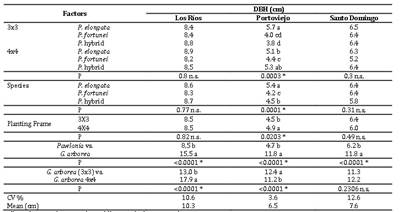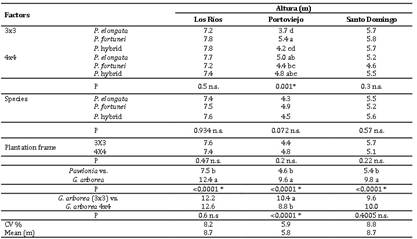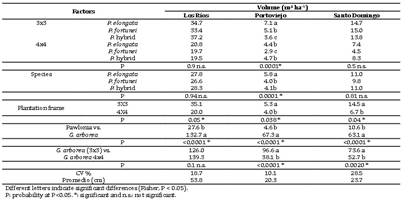INTRODUCTION
In Ecuador, the trend in recent years reveals a systematic reduction of forests due to irrational timber exploitation (Un-Reed (FAO), 2018). Although the deforestation rate has decreased (year 2012) compared to the years 1990 and 2000. The deforestation rate for the period 1990 - 2000 was 92.787 ha year-1, while for the period 2000 - 2008 it decreased to 77.742 ha year-1 and for the year 2012 it has been estimated that the deforestation rate was 65.880 ha year-1 (FAO, 2014). In 1990 68% of forest area was held, but in 2018% fell to 56% (Sierra et al., 2021), Introduction and evaluation of new fast-growing forest species for timber production are alternatives to meet the objectives of the National Plan for Forestation and Productive Reforestation (Grijalva et al., 2016) and reforesting part of the 2.62 million hectares available for reforestation (Ministerio del Ambiente, 2012).
The Paulownia genus has multiple advantages: great adaptation to all types of soils, reduced handling, disease resistance, lower water consumption, high productivity and growth capacity, which is considered one of the highest in the plant kingdom (Corredoira et al., 2010). Additionally, it stabilizes soil erosion, produces considerable biomass, CO2 fixation, and fodder for livestock (Agricultural Extensión Service, 2005; Knezevic et al., 2009).
This genus, native to Asia, is distributed in temperate and cold climates, growing from sea level to 2400 m.a.s.l. with rainfall between 500 and 2000 mm year-1 (Lucas-Borja et al., 2011), Ecuador has these conditions in several regions. Since there is no previous study, three localities on the Ecuadorian coast were selected, and where there are already Gmelina forest exploitations, where Paulownia can be considered as a fast-growing alternative.
The goal of this research was to evaluate the growth of three species of the genus Paulownia using two planting frames in three locations in Ecuador as a medium-term alternative for productive and afforestation purposes.
MATERIALS AND METHODS
Experiment Locations. The Table 1 describes the biophysical characte-ristics in which the research was carried.
Biological material. Clones of Paulownia species were imported from the World Paulownia Institute (USA). The Gmelina arborea plants were obtained from REFOREI nursery (Esmeraldas-Ecuador).
Treatments. Six treatments were evaluated at the sites as a result of the interaction of two factors (three Paulownia species and two planting frames) plus two additional factors (local control in two planting frames) (Table 2). The experimental unit used was 25 trees and the sampling unit consisted of 16 trees.
Variables evaluated. During the second year of planting, the following variables were evaluated:
- Diameter at breast height (DBH): Measured at 1.3 m height in those individuals that reached 2.0 m, using a Haglöf tree caliper graduated in milli-meters.
- Total height (TA): Considered from ground level to the apical bud, using a Sokkia telescopic height meter graduated in centimeters.
Tabla 1 Location and biophysical characteristics of the experimental sites
| Parameter | Location | |||
| Manabí | Los Ríos | Santo Domingo | ||
| Climate zone | Tropical Dry | Tropical Humid | ||
| Average Temperature °C | 24.6 | 25.5 | 24.2 | |
| Annual rainfall (mm) | 550 | 2223.9 | 3045.1 | |
| Altitude (masl) | 44 | 75 | 300 | |
| Latitude | -1.161547 | -1.09999999 | -0.2275 | |
| Longitude | -80.38325 | -79.4616667 | -79.2083333 | |
| Soil texture | sandy-loam | loam | sandy-clay-loam | |
Table 1 Treatments
| Treatment | Species | Planting frame (m) |
| Factorial | ||
| T1 | Paulownia fortunei Hemsl | 3 x 3 |
| T2 | Paulownia elongata S.Y.Hu | |
| T3 | Paulownia hybrid (P. fortunei × P. elongata) | |
| T4 | Paulownia fortunei Hemsl | 4 x 4 |
| T5 | Paulownia elongata S.Y.Hu | |
| T6 | Paulownia hibrido (P. fortunei × P. elongata) | |
| Additions | ||
| Gmelina arborea | 3 x 3 | |
| Gmelina arborea | 4 x 4 | |
- Volume (V): It was calculated with the following formula:

Being:
V= Volume in cubic meters
DBH = Diameter at breast height in meters
π = Numerical constant (3.1416)
CH = Commercial height in meters
s = Shape factor (0.7 according to Ministerial Agreement 327 of the Ministry of Agriculture and Livestock of Ecuador).
Experiment Design and Statistical Analysis. A factorial experiment plus two additional treatments were used under a Split Plot Design with three replications; the planting frame factor was placed in the large plot and the species factor in the sub-plot. The normality of the data was determined using the Shapiro-Wilks test (modified). The Fisher's LSD test at 5% was used for means comparison. The software Infostat® Professional 2020 version was used for statistical analysis.
Field experimental management. The trees were two years old at the time of evaluation. Holes of 0.4 m long x 0.4 m wide x 0.4 m deep were made in the soil for plant them. The base fertilization was 50 g of compound fertilizer 19-8-12-2 (SUMICOAT®) and 500 g of organic matter, with the addition of 5 g of moisture-retaining polymer (Hidrokeeper®). To avoid competition for nutrients and moisture, and to reduce possible pest hosts, the experiment was kept free of weeds, with manual weeding of the area around the tree stem, done every trimester.
RESULTS AND DISCUSSION
Diameter at breast height (DBH)
There was high statistical significance for planting frame and species interaction at Portoviejo location (Dry Tropic), and no statistical significance was detected for Los Ríos and Santo Domingo (Humid Tropic) (Table 3).
In Portoviejo, four ranges of statistical significance were established for the interaction between planting frame and species (Table 3), with the first range being P. elongata with a planting frame of 3 x 3 m and a DBH of 5.7 cm, followed by P. hybrid with a planting frame of 4 x 4. In the last range is P. hybrid with a planting frame of 3 x 3 m with a DBH of 3.8 cm. The species that obtained the best results was P. elongata with a DBH of 5.4 cm; on the contrary, the 4 x 4 m planting frame obtained the best response with a DBH of 4.9 cm.
For Los Ríos and Santo Domingo, the species that obtained the best response were P. hybrid and P. elongata with DBH of 8.7 and 6.4 cm, respectively. Concerning the planting frame, the best response was obtained in the 3 x 3 m frame with a DBH of 8,5 cm for Los Ríos and 6.4 cm for Santo Domingo.
In the three sites, high statistical significance was detected when contrasting the Paulownia species with G. arborea, the latter obtaining the best DBH with ranges between 11.8 to 15.5 cm versus the Paulownia species that reached DBH of 4.7 to 8.5 cm. G. arborea, in the two planting frames, showed high statistical significance for Los Ríos and Portoviejo, and no significance for Santo Domingo. The best response was achieved in the 4 x 4 m planting frame, with DBH between 11.2 and 17.9 cm.
Table 3 DBH for species, planting frames and their interaction in the study sites

Different letters indicate significant differences (Fisher, P < 0.05).
P: probability at P < 0.05. *: significant and n.s.: not significant.
Paulownia species were exceeded by G. arborea in the three locations due to its better adaptation, growth of G. arborea is close to that reported by (Ávila-Arias et al., 2014), who mention DBH values of 16 to 17 cm and TH of 7 to 10 m in the second year. In some regions of Asia, Paulownia plantations show DBH values between 5.0 to 7.9 cm per year (Baier et al., 2021). In China, a study of 2-year-old Paulownia at a spacing of 4 m, had DBH values of 2.43 to 2.67 cm on average, lower values than those obtained in the present study (Zhao et al., 2019).
Total height (TH)
There was high statistical significance for the plantation frame interaction and species in the Dry Tropic locality, and no statistical significance for the Humid Tropic localities (Table 4).
In Portoviejo, for the interaction plantation frame by species, Fisher detected four ranges of statistical significance (Table 4), with P. fortunei being in the first range in the frame of 3 x 3 m with a value of 5.4 m, followed by P. elongata in 4x4 planting frame. In the last rank, P. elongata was located in the 3 x 3 m planting frame with a height of 3.7 m. The species that obtained the best results was P. fortunei with a value of 4.9 m; while the planting frame of 4 x 4 m obtained the best response with a value of 4.8 m. In Los Ríos and Santo Domingo, the species that obtained the best response was P. hybrid with heights of 7.6 and 5.6 m respectively. Likewise, the best response was obtained in the 3 x 3 m planting frame with heights of 7.6 m in Los Ríos and 5.7 m in Santo Domingo.
When contrasting the Paulownia species with G. arborea, a high statistical significance was detected, in the three study sites, with the control obtaining the best height with ranges between 9.8 and 12.4 m compared to the Paulownia species with heights between 4.6 and 7.5 m.
G. arborea, in the two planting frames, presented high statistical significance for the Portoviejo locality, and no significance for Los Ríos and Santo Domingo. In general, the best response was obtained in the 4 x 4 m planting frame, with values between 10.0 and 12.6 m. The results show that Paulownia was more efficient in temperate and humid climates such as Los Ríos and Santo Domingo (humid tropics), which is in agreement with responses obtained in China with values of 3 to 4 cm yr-1 for DBH and 3 to 4 m yr-1 for TH (Zhao-Hua et al., 1986). In Albania, a plantation with 1 m spacing had an average height of 4.25 m in the first year (Icka et al., 2016). In Ohio, two years old Paulownias reached an average height of 8.0 m (Williams & Wang, 2021). Meanwhile, in studies conducted in Asia, the height of Paulownia trees averages between 2.73 to 4.43 m per year (Baier et al., 2021). Similarly, in Ecuador, growth of Paulownia species is reported between 65.53 to 70.51 cm at 93 days, obtaining 5.23 to 5.64 m in two years old trees (Ramos Veintimilla et al., 2020). In an experiment conducted in China with distances of 4 meters, average heights of 9.95 to 11.06 m were obtained, results close to those obtained in Los Ríos (Zhao et al., 2019).
High statistical significance was detected in Portoviejo (Dry Tropic) and no statistical significance in Los Ríos and Santo Domingo (Humid Tropics) for the interaction between planting frame and species. In addition, at Los Ríos and Santo Domingo, statistical significance was observed for planting frame and no significance for species (Table 5).
In Portoviejo, Fisher detected three ranges of statistical significance for the planting frame by species interaction (Table 5), with P. elongata in the first range in the 3 x 3 m planting frame with a volume of 7.1 m3 ha-1; while in the last range were the interactions 3 x 3 m with P. hybrid and 4 x 4 m with P. fortunei with volumes of 3.6 and 2.9 m3 ha-1 respectively. The species that obtained the best results was P. elongata with a value of 5.8 m3 ha-1; while the 3 x 3 m planting frame obtained the best response with a value of 5.3 m3 ha-1.
In Los Ríos and Santo Domingo, the species that obtained the best response was P. hybrid with values of 28.3 and 11.0 m3 ha-1, respectively. Similarly, the best response was achieved in the 3 x 3 m planting frame with volumes of 35.1 m3 ha-1 in Los Ríos and 14.5 m3 ha-1 in Santo Domingo.
The comparison of Paulownia species versus G. arborea, in all the locations under study, showed high statistical significance, with the check treatment obtaining the best value with ranges between 63.1 and 132.7 m3 ha-1 while the Paulownia species between 4.6 and 27.6 m3 ha-1.
G. arborea, in two planting frames, showed high statistical significance in Portoviejo and Santo Domingo, and no significance in Los Ríos. In general, the best response was in the 3 x 3 m planting frame, with volumes between 73.6 and 126.0 m3 ha-1.
In general, Paulownia species did not exceed the values achieved by the control treatment G. arborea, possibly due to the spacing used. The literature recommends spacings of 5 x 5 m, 6 x 5 m, and even 8 x 5 m (Rao et al., 1986; Zongran et al., 1996) .
The control treatment presented the best averages of DBH, total height, and volume. In commercial plantations G. arborea is managed with smaller spacing; with frames of 2.5 x 2.5 m and 3.5 x 3.5 m, compared to those required by Paulownia spp; in (Muñoz Flores et al., 2009).
In Mediterranean climates, annual volume yields of between 26.3 to 45.5 m3 ha-1 are obtained, and are considered a viable production alternative (Fernández-Puratich et al., 2017). In this study, only the Los Ríos locality has a comparable average of 28.3 m3 ha-1, however, it is still exceeded by the species used as a control in this trial.
Several studies carried out with Paulownia have significant differences in growth, due to climatic and environmental conditions (Jakubowski, 2022). Mass production is highly dependent on soil quality (Tu et al., 2017).
CONCLUSIONS
Paulownia species presented different behaviors with better responses in the humid tropic localities, possibly due to the adequate edaphoclimatic conditions for its development. Paulownia did not outperform the local control, which is adapted to the environmental conditions of each zone.
From the productive point of view, Paulownia species do not meet the expectations at the commercial level in the forest areas of the humid tropics of Ecuador.












 uBio
uBio 




